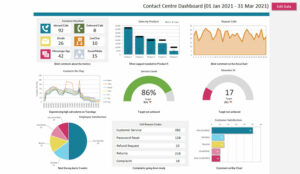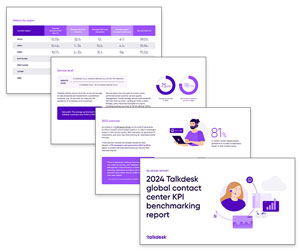Benchmarking and balanced scorecards are two wildly different initiatives. Both can work well in the contact centre.
After offering a clear definition for each, let’s analyse how contact centres can use both, in tandem, to improve customer service.
What Is a Balanced Scorecard?
A balanced scorecard divides metrics into categories. These categories should reflect the fundamental areas of contact centre performance.
For example, categories could include “advisor”, “customer” and “business”. An alternative might be “people”, “customers”, “financial” and “process”.
Whatever the case, the goal is to track a relatively equal number of metrics across each category to achieve a well balanced centre and clear view of performance.
The goal is to track a relatively equal number of metrics across each category to achieve a clear view of performance
Yet, to a degree, balanced scorecards have disappeared over the past five to ten years. Why? Because contact centres:
- Failed to create a data flow to track/measure each metric easily
- Overloaded the scorecard and became confused over which metrics to prioritize
- Tampered with metrics to mislead executives about actual performance
- Failed to teach stakeholders about the subtleties of productivity metrics
However, this has had a detrimental impact on the contact centre – as many now lack an understanding of how metrics influence one another.
“Bringing back the principle of the balanced scorecard – so businesses understand the relationship between processes, customers and costs – is important,” says Ian Golding, Founder of the Customer Experience Consultancy. “That discipline needs to return.”
Having a clear picture of performance also positively differentiates the balanced scorecards while benchmarking examines metrics in isolation.
Discover more insights into the nuts and bolts of a balanced scorecard in our article: What Is a Balanced Scorecard and How Do You Create One?
What Is Benchmarking?
Benchmarking is the art of comparison. In the contact centre, managers can compare metric scores in three ways:
The first of these is often the most useful. It allows contact centres to track a metric over time to gain a sense of progress. This is great for measuring goal achievement.
Benchmarking against the competition, on the other hand, is good for finding opportunities to differentiate and excel.
Just be careful when doing this, as other contact centres may not measure a metric in the same way. Also, figures for metrics – such as Average Handling Time (AHT) – may well be different, as a competitor may have more or less self-service, for example.

Justin Robbins
These same warnings apply to the third and final method of benchmarking. However, benchmarking against the industry is still useful for understanding industry trends.
“If you see that 70% of contact centres within your sector measure first contact resolution (FCR) but you don’t, maybe that should provoke a conversation around that metric,” says Justin Robbins, Chief Evangelist at CX Effect.
So, these final two ways of benchmarking can bring real value. Yet, when it comes to the balanced scorecard, internal benchmarking will likely be the focus – as we explore below.
Find the latest industry data to benchmark your contact centre in our report: What Contact Centres Are Doing Right Now (2021 Edition)
Can They Work Together?
When implementing a balanced scorecard, the contact centre is trying to achieve something. It’s not only there for good measure.
Each metric should inform the contact centre. If not, then why put in the effort to track the measure?
Benchmarking enables a manager to know in an instant which metrics are higher or lower than normal. They can then assess the balanced scorecard to review the wider impact and check for a healthy performance.
Next, it’s time to act. The manager should have a series of corrective actions in their toolbox to pick performance back up.
Alongside these actions should be accountability as to who does what. By clearly defining roles, the contact centre can bounce back and turn each metric “green”.
On this colour theme, setting a traffic light system – for each metric on the scorecard – can help guide the course back to a healthy performance.
Green is the healthy benchmark, amber raises cause for concern, while red signals the panic alarm. If the data flows in real time, having such a system can bolster intraday management.
On the topic of intraday management, here’s a great guide to better manage performance in the moment: 12 Top Tips for Intraday Management in the Contact Centre
Getting Back to the Truth
Combining the art of benchmarking with the balanced scorecard brings value – but only if managers and stakeholders can rely on the data.
A big problem across the contact centre industry is that too many leaders take numbers at face value and jump to the wrong conclusions.
In doing so, the contact centre will either get the impression that they’re completely amazing, so they don’t need to do anything, or they will make the wrong decision. When this happens, contact centres start fixing the wrong things.
This is according to Ian Golding, who says: “We need to move away from gamifying numbers and into a world where we tell the truth.”
Unfortunately, many are stuck in a realm where bonuses rely on hitting numbers and people are held accountable for a slip in metric scores. This leads to manipulation of results.
Surely, this wouldn’t happen in most contact centres? Well, many metrics are often tampered with to deceive senior management. For example:
- Average Handling Time (AHT) is manipulated by leaders making a succession of one- or two-second calls to their own contact centre.
- Customer Satisfaction (CSAT) is manipulated by leaders only collecting data after calls with a positive resolution.
- First Contact Resolution (FCR) is manipulated by leaders who consider a transferred call as one contact, despite two advisors getting involved.
The balanced scorecard can suppress these manipulations because if someone manipulates a number, the others metrics will suggest that something is not quite right.
Yet, the sad truth is that human beings will eliminate anything that makes their lives difficult – which again hints at why the balanced scorecard is falling by the wayside.
Be Cautious of Benchmarking
The obsession with score chasing and gamifying numbers is pushing contact centres past the point where many of their metric scores offer a truthful reflection of reality.

Ian Golding
“For any benchmark to be trustworthy – be it internal or external – a clear operational definition of where that number comes from and how it’s calculated must be provided,” says Ian. “Otherwise, it’s not a reliable source to benchmark against.”
However, such a definition is rarely provided. This became such a widespread issue within the UK banking industry that the FCA had to step in.
The regulator concluded that the way banks were reporting customer perception scores was so far from the truth that they must take measures into their own hands.
In doing so, the FCA launched an independent survey of banks – sending a message to the banking industry that they cannot be trusted to do this by themselves.
At the time, it was mandated that the results of this survey had to be published within bank branches and on their websites.
All of this because benchmarking figures were being twisted, as contact centres:
- Changed the wording of the question
- Asked only a selective group of customers
- Measured it at a favourable point in the customer journey
Even for standard metrics with a seemingly clear proposition, such as the Net Promoter Score (NPS), this became an issue. The way banks were reporting numbers was just fantasy. Yet the problem extends beyond this industry alone.
When it comes to internal benchmarking, make sure that everybody has a clear understanding of how metrics are measured
So, when it comes to internal benchmarking, make sure that everybody has a clear understanding of how metrics are measured. Then, the balanced scorecard becomes a much more reliable and valuable tool in monitoring contact centre performance.
In terms of external benchmarking, seek out publicly available secondary research. Independent research is the best source, as long as it has a clear methodology.
Final Thoughts
Benchmarking and a balanced scorecard are two entirely different initiatives. Yet, when working in tandem, their value is often amplified.
Setting benchmarks against different metrics within the balanced scorecard gives managers great insight into the health of the contact centre.
When metrics dip below the benchmark, corrective actions may then be taken.
In addition, with the balanced scorecard, management can see the full extent of the issue and how metrics influence one another.
By doing so, the contact centre can also spot when one metric is being manipulated and act. This creates a clearer picture of performance across the business.
Thanks to Charlie Mitchell for this article.
Uncover lots more insights into how contact centres can make better use of their metrics by reading our articles:
- How to Use Inbound Call Centre Metrics to Drive Performance
- A Quick Guide to Call Centre Reporting
- Podcast: Is It Time to Rethink Your Call Centre Metrics?
Author: Charlie Mitchell
Reviewed by: Robyn Coppell
Published On: 2nd Mar 2022 - Last modified: 9th May 2024
Read more about - Call Centre Management, benchmarking, Charlie Mitchell, Editor's Picks, Ian Golding, Key Performance Indicators (KPIs), Metrics, Performance Management, Scorecard






































